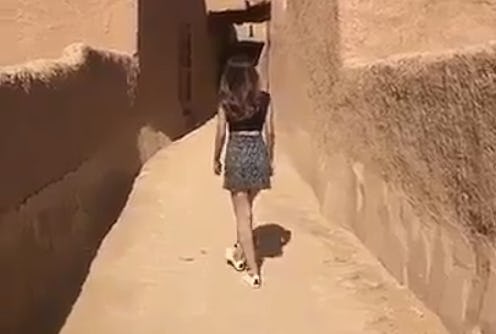
According to the Saudi Arabian newspaper Okaz, a video of a woman wearing a miniskirt in Saudi Arabia is being investigated by authorities. The six seconds-long video caused a storm of mixed reactions among Twitter users in the Middle Eastern country. In the video, the young woman is seen walking around a historic fort in Ushayqir village, accompanied by whoever is recording the video.
The Ushayqir historic village is located in the Najd province, considered one of the most conservative parts of the country. The perception of Najd as a highly religious region of the kingdom comes from the fact that it is where Muḥammad ibn ʿAbd al-Wahhāb was born. In Islamic history, Wahhab is known as the creator of Wahhabism — a stringent form of Sunni Islam.
So far, several media outlets have identified the woman as a model named "Khulood." The video was first shared by the model on Snapchat and then later on received more attention on Twitter.
Journalists chimed in to offer their two cents on the incident. Some called for the enforcement of a stricter religious code while others praised the woman for being brave. One journalist known as Khaled Zidan tweeted for more robust implementation of the Saudi dress code. But others disagreed — Fatima al Issa viewed the outburst against Khulood as a sign of hypocrisy. She said that if the woman was a foreigner, she would have received praise for her beauty, but given the fact that she is Saudi, people are demanding her arrest.
The moral police in Saudi Arabia, a contingent that works under the Committee For The Promotion Of Virtue And The Prevention Of Vice, tweeted that it had taken notice of the video and would be conducting an investigation with relevant authorities.
Saudi dress code is a slightly complicated subject — for starters, it is one of the very few Muslim countries where an official dress code is enforced on those living within the kingdom. Another example is that of Iran, where the hijab or headscarf is mandatory.
In Saudi Arabia's case, women are expected to wear loose-fitted coverings for their bodies. Most of the time, this loose-footed garment is called an "abaya." It resembles a long overcoat and is frequently found in dark shades of blue, black, maroon, and other subdued hues. While the loose-fitted garment is compulsory, the headscarf is not mandatory.
Khulood's video renewed locals' debate on modesty, dress code, and the monarchy's rulings. Islam places emphasis on modesty and expects both men and women to practice it equally, but some feel that the onus of chaste behavior is thrown squarely on the shoulders of women. While some still believe that Khulood should have adhered to the kingdom's dress code, others found the model's short video highly inspiring.